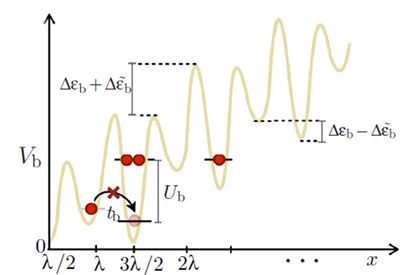Strong correlations in one dimension
Quantum many-body systems of strongly correlated particles are very interesting from technological and fundamental points of view. Yet their theoretical/numerical description is not complete. (Quasi) one-dimensional geometries are an exception to that problem.

Strong correlations in quantum many-body systems often result in: (i) quasiparticles (elementary excitations) with changed statistics (i.e. fermion to boson, or fractional) or fractionalised charge/spin, (ii) string or non-local order (iii) unconventional non-ordered states (i.e. non-Fermi liquid, spin liquid), and other exotic physical properties. Additionally strong correlations may influence or completely change the effects of other system features like disorder (i.e. many-body localisation) or wavefunction topology (as in strongly correlated topological insulators). As such strongly correlated quantum many-body systems are active area of fundamental physics research. Materials with strongly correlated electrons are also of great technological importance due to its electrical and magnetic properties (i.e. high-Tc superconductors).
Unfortunately theoretical description of strongly correlated systems faces severe challenges, many of which may be linked to objective problem of dealing with many-body wavefunction (exponential growth of Hilbert space) in conjunction with non-trivial entanglement between blocks of the system. This is reflected in severe challeneges in numerical simulations of such systems on classical computers. The famous “sign problem” occurring in strongly correlated fermion, or frustrated strongly correlated boson systems is in worst case of NP-complete numerical complexity.
One-dimensional systems (with short range interactions) are exception to that problems: the boundary connecting two parts of the system is point-like which makes numerical methods like Density Matrix Renormalisation Group very efficient for solving such models. Many one-dimensional models are also amenable for exact solution using Bethe-ansatz or other method. This makes one-dimensional systems an intriguing alternative for theorists studying strong correlations.
Quantum simulations of one-dimensional models
Recently quantum simulators using ultra-cold gases on optical lattices have enabled to experimentally create very broad class of one-dimesional models. Such systems are now an ideal playground for studying in detail various physical phenomena caused or influenced by strong correlations.
Our research consisted of:
- Correlated hopping fermionic model with exact solution in extreme correlations limit, exhibiting string “hidden” order protected by a spin-gap and (quasi)long-range hole superconductivity,
- Peirels transition in bosonic system. Conventionally Peirels transition is associated with fermion systems and dependent on Fermi surface. Here it was driven by strong boson correlations.
- Interplay of system symmetries in a rise of symmetry protected topological phase: spontaneous breaking of one symmetry brings (quasi)long-range order necessary for formation of topological insulator, which topological properties are protected by another symmetry.
- Emergent symmetry protected topological phase, where system spontaneously accommodates order with higher symmetry, necessary for protection of topological phase.
- Charge fractionalisation in mobile solitons. Charge fractionalisation and topologically protected edge states may appear on domain walls. In one dimension such domain walls are usually mobile, leading to soliton quasiparticles with fractionalised quantum numbers.
- Superfluids with unconventional clustering properties resulting from strong correlations and correlated hopping in bosonic system.
- “Clustered superfluids in the one-dimensional Bose-Hubbard model with extended correlated hopping”, Julia Stasińska, Omjyoti Dutta, Luca Barbiero, Maciej Lewenstein, and Ravindra W. Chhajlany, Phys. Rev. B 103, 134513 (2021), DOI: 10.1103/PhysRevB.103.134513
- “ℤn solitons in intertwined topological phases”, D. González-Cuadra, A. Dauphin, P. R. Grzybowski, M. Lewenstein, and A. Bermudez, Phys. Rev. B 102, 245137 (2020) DOI: 10.1103/physrevb.102.245137
- “Dynamical Solitons and Boson Fractionalization in Cold-Atom Topological Insulators” D. González-Cuadra, A. Dauphin, P. R. Grzybowski, M. Lewenstein, and A. Bermudez, Physical Review Letters 125, 265301 (2020), DOI: 10.1103/PhysRevLett.125.265301
- “Symmetry-breaking topological insulators in the “ℤ2 Bose-Hubbard model” Daniel González-Cuadra, Alexandre Dauphin, Przemysław R. Grzybowski, Paweł Wójcik, Maciej Lewenstein, and Alejandro Bermudez, Phys. Rev. B 99, 045139 (2019), DOI: 10.1103/PhysRevB.99.045139
- “Intertwined topological phases induced by emergent symmetry protection” Daniel González-Cuadra, Alejandro Bermudez, Przemysław R. Grzybowski, Maciej Lewenstein & Alexandre Dauphin, Nature Communications volume 10, Article number: 2694 (2019), DOI: 10.1038/s41467-019-10796-8
- “Strongly correlated bosons on a dynamical lattice” D. González-Cuadra, P.R. Grzybowski, A. Dauphin and M. Lewenstein, Physical Review Letters 121 (9), 090402 (2018), DOI: 10.1103/PhysRevLett.121.090402
- “Hidden String Order in a Hole Superconductor with Extended Correlated Hopping” Ravindra W. Chhajlany, Przemysław R. Grzybowski, Julia Stasińska, Maciej Lewenstein, and Omjyoti Dutta, Phys. Rev. Lett. 116, 225303 (2016) DOI: 10.1103/physrevlett.116.225303
Beyond-Luttinger-liquid thermodynamics
One-dimensional systems are unique and important topic on its own. Their distinguishing feature is a lack of stable Fermi liquid, unlike in two- and three- dimensional systems. Luttinger liquid theory is the cornerstone of contemporary understanding of one-dimensional system. It describes a collapse of Fermi liquid in one dimension and emergence of collective bosonic excitations. This theory unifies weak- and strong- coupling limits but is restricted to very low temperatures where linearization of particle kinetic energy close to Fermi level is allowed. Presently, due to progress in experimental techniques and simulations, there is active ongoing research of thermodynamic effects beyond Luttinger liquid theory. We are interested in such effects in strong correlations regime.

